
An entrepreneur running on a large clock, trying to keep pace with the moving hands, in a metaphorical representation of racing against time
Let me start with a question:
Do you sometimes feel overwhelmed and struggle to stay focused on important tasks as an entrepreneur? I bet you did. We all have a universal struggle with time, There’s always more to do than time available.

A creatively designed image representing a professional’s life divided into two halves
My Personal Journey: The Dream and The Downfall
I had a dream, a burning ambition, literally. Ever since I was a young boy in Bettiah, a small town with big dreams, I had my heart set on joining the Air Force. It was more than a career choice; it was a calling. The thought of soaring through the skies, defending my country, and wearing that prestigious uniform was everything I ever wanted.

An illustration of a hopeful journey, depicting a young man and his father traveling to Patna for an Air Force exam
Growing up in a small town, resources and guidance were scarce. But what I lacked in resources, I made up with hard work. I excelled in my studies, often staying up late into the night and preparing for the day I would finally get my chance to prove myself.
The day finally arrived when I was old enough to apply for the Air Force. Filled with a mix of excitement and nervous energy, I carefully filled out the application form, ensuring every detail was perfect. When the call for the exam came, it felt like a validation of all my efforts. My father, sensing the importance of this moment, accompanied me on the long journey to Patna, where the exam centre was located.
The journey was long, taking nearly 10 hours, but it was filled with hopeful conversations with myself and my dreams of the future. As we neared Patna, my heart pounded with anticipation and a bit of anxiety. This was it, the moment that could define my entire future.
However, amidst all this preparation and excitement, I had overlooked one crucial detail – pasting my photograph on the admit card. This seemingly minor oversight was a result of my chronic habit of procrastination, something I had always struggled with but never fully addressed.
In a frantic rush, I managed to paste my photo on the admit card, telling myself that it was a minor thing, nothing that could jeopardize my chances.
But as I stood in line at the Air Force camp, surrounded by other candidates, a sinking feeling began to set in. When the examiner called out the roll codes, my heart sank further. I was the only one whose roll codes didn’t match among a batch of 25. The examiner, a stern officer with a no-nonsense attitude, took one look at my admit card and pointed out that not only was my photo upside down, but also that the date of my exam had passed two days ago.

His reaction was swift and harsh. He used a string of army slangs and drove me away from the camp. The journey back home was the longest and most painful I had ever experienced. The shame and regret were overwhelming. I wasn’t able to make eye contact with my dad.
Adding to my misery, two of my classmates, whom I had always outperformed academically, got selected. Back at home, everyone was surprised and confused about my rejection. I was the topper of my class, the one everyone had pinned their hopes on. The weight of their expectations made it even worse.

I couldn’t bring myself to admit the truth to anyone – that I didn’t even appear for the exam due to my own carelessness and procrastination. It was a harsh lesson, one that made me realize the consequences of putting things off until the last moment. This experience, as painful as it was, became a turning point in my life. It taught me the value of time, the importance of attention to detail, and the need to overcome my habit of procrastination. It was a lesson learned in the hardest way possible, but it was one that I would carry with me for the rest of my life.

For a large part of my adulthood I have fought with procrastination and the shame and regret which comes with it, but also realized I needed to confront my chronic habit of delaying tasks if I ever hoped to achieve my goals.
The Turning Point: Discovering ‘Eat That Frog’
It was during the COVID-19 pandemic I stumbled upon Brian Tracy and his book that would significantly impact my journey towards self-improvement. “Eat That Frog” by Brian Tracy was not just another self-help book; it became a catalyst of change in my life.
The book’s central premise, based on the old saying that if you eat a live frog first thing in the morning, nothing worse can happen to you for the rest of the day, resonated with me. It was about tackling the most challenging task first, the one I was most likely to procrastinate on.
I began to understand the root of my procrastination. It wasn’t just laziness or poor time management; it was deeper, tied to my fears, anxieties, and a tendency to seek comfort in the familiar. This was my aha moment.
Slowly, I began to notice changes. Tasks that would have taken me days to start were now being addressed immediately. My confidence grew as I saw myself making progress in areas where I had previously stalled. It wasn’t smooth. There were days when the old habit reared its head, tempting me to fall back into old patterns. It was like making overall progress but on a rollercoaster ride.
Today, I can’t claim that I’ve completely ‘cured’ my procrastination. It’s a battle I continue to fight, but now with a better understanding and more effective tools it’s more or less in control. It can’t do a significant damage.
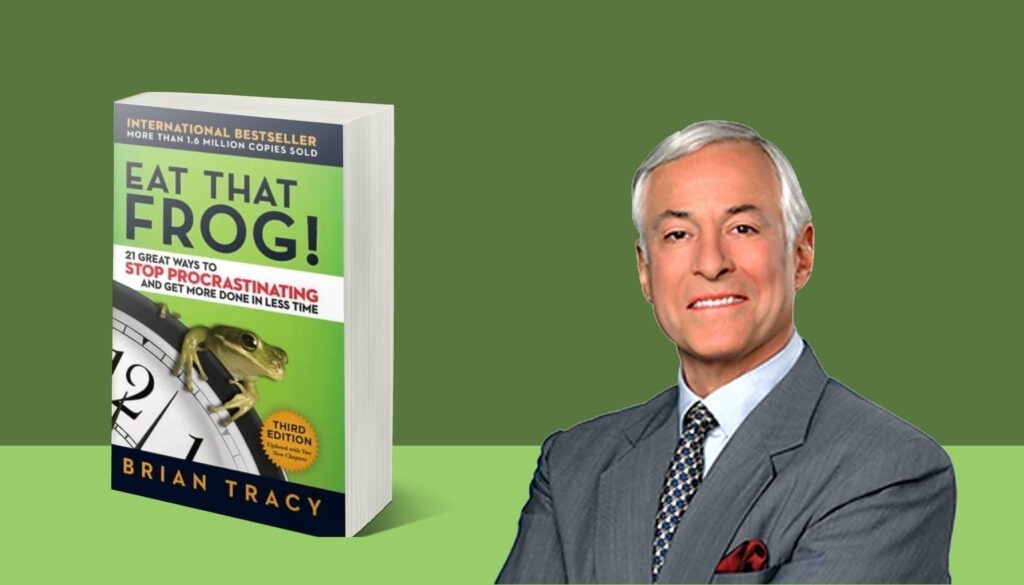
‘Eat That Frog’ and it’s Core Philosophy
Brian Tracy is a Canadian-American motivational public speaker and self-development author. He has authored over 70 books on leadership, sales, managerial effectiveness, and business strategy.
Eat That Frog offers simple but powerful productivity tactics to overcome procrastination by synthesizing key insights from time management literature. While the advice is not completely new, Tracy’s gift is in distilling these ideas into an actionable framework.
Central to the book’s philosophy is Mark Twain’s quote: If it’s your job to eat a frog, it’s best to do it first thing in the morning. And If it’s your job to eat two frogs, it’s best to eat the biggest one first.
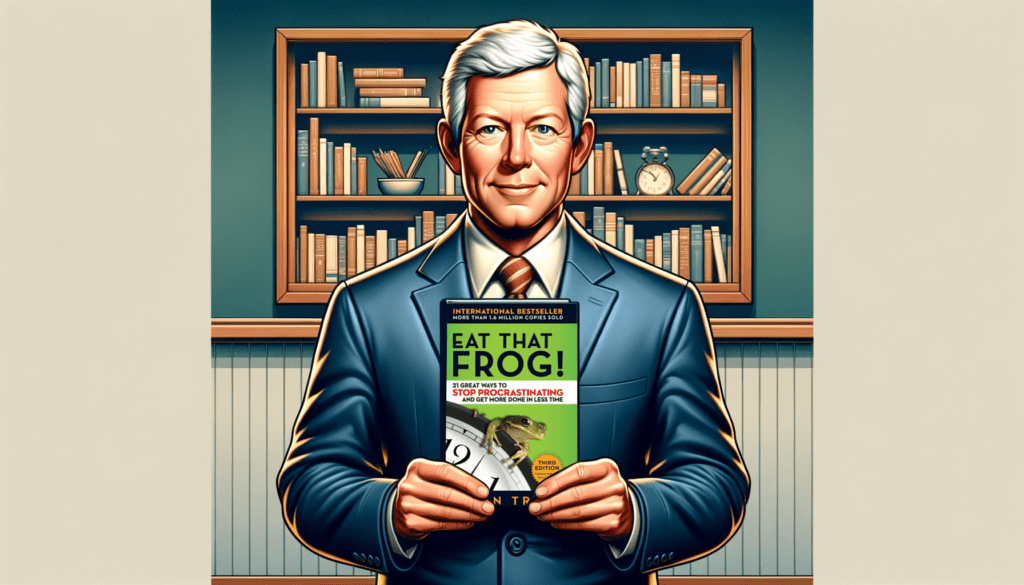
Brian Tracy, a motivational speaker and author, holding a copy of “Eat That Frog”
Eat That Frog = Tackle Your Biggest Priority First
This metaphor basically means tackling your biggest, ugliest, most important project or task before anything else. It pushes you to overcome procrastination and zero in on top priorities early when you have the most energy. This builds momentum to power through your day. The key, he asserts, is not trying to do everything but rather focusing on the most important tasks that make a real difference in one’s life.
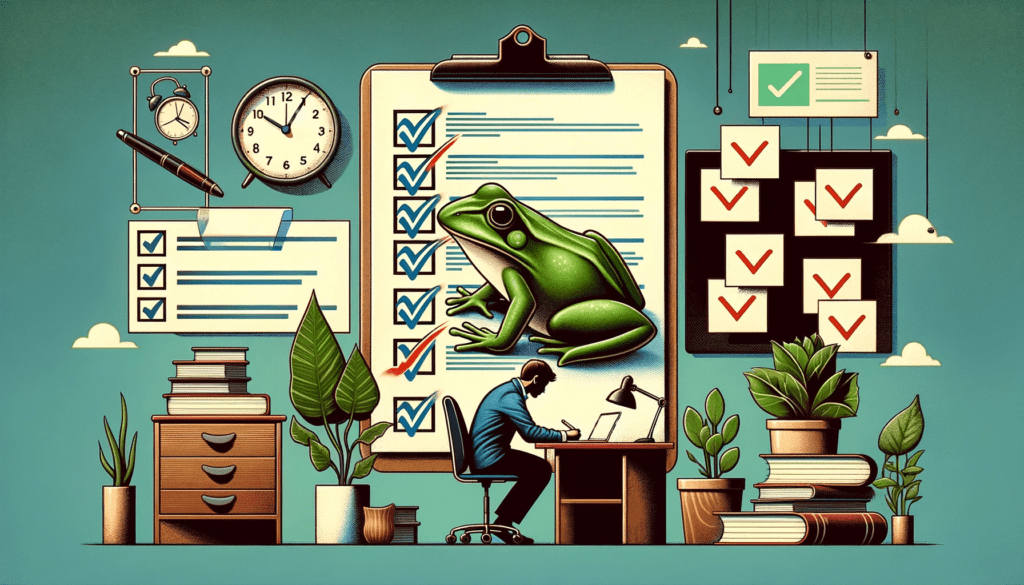
The book is divided into 21 chapters time to spill the tea on all of them:
Chapter 1 – Set the Table
Clarity is important, knowing precisely what you want to achieve is crucial for success. Writing down your goals and objectives is critical to avoid vagueness and confusion, which often lead to procrastination.

Chapter 2 – Plan Every Day In Advance
Planning is like bringing the future into the present, allowing you to take action immediately. Effective planning helps you overcoming procrastination, maximizing productivity, and ensuring the best use of mental, emotional, and physical energy. Every minute spent in planning saves ten minutes in execution.

Chapter 3 – Apply the 80/20 Rule to Everything
The Pareto Principle states that 20% of activities account for 80% of results. Focus on the ‘vital few’ – the top 20% of tasks that yield the most significant results, rather than the ‘trivial many’ that contribute little. The truth is most of us tend to procrastinate on the most valuable 20% of tasks.

Chapter 4 – Consider the Consequences
You should consider the long-term consequences of actions in determining their priority. Long-term thinking improves short-term decision-making and is a key predictor of success.

An image of a person playing chess, focusing on a chessboard where each move symbolizes strategic, long-term planning versus short-term tactics
Chapter 5 – Practice the ABCDE Method Continually
This chapter introduces the ABCDE method, a priority-setting technique that helps distinguish between varying levels of important tasks. Tasks are categorized from ‘A’ (must do) to ‘E’ (eliminate), allowing for a clear prioritization of activities based on their importance and consequences.

Chapter 6 – Focus On Key Result Areas
Knowing & Understanding the specific results you are expected to deliver is essential for peak performance. He explains that every job can be broken down into key result areas, and success or failure in a job is often determined by performance in these areas.
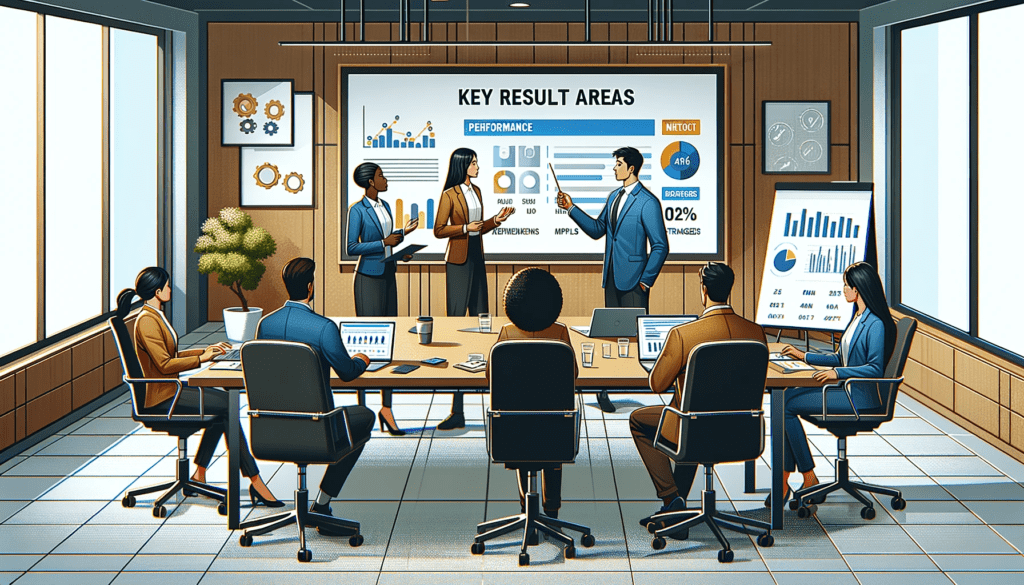
Chapter 7 – Obey the Law of Forced Efficiency
The Law of Forced Efficiency states that there’s always enough time to do the most important things. You should focus on key tasks with the most severe consequences for non-completion. Continuously ask yourself about your highest value activities to stay focused on crucial tasks.

Chapter 8 – Prepare Thoroughly Before You Begin
Prepare like an archer with an arrow drawn, This can give you the necessary mental push to begin your highest value tasks. Clearing your workspace and gathering all necessary materials helps you focus and start more easily. The cleaner and more organized your work area, the easier it is to begin and maintain momentum in your work.

Chapter 9 – Do Your Homework
You should continuously learn and improve skills to complete tasks effectively. Feeling inadequate, unconfident, or lacking in a particular area can lead to procrastination. Being good at a task increases motivation, energy, and the ability to complete it efficiently.

Chapter 10 – Leverage Your Special Talents
Identify your strengths, recognizing what you do well and enjoy can lead to significant contributions and success. Focus on tasks where your strengths can be applied effectively.

Chapter 11 – Identify Your Key Constraints
In every task, there’s always a limiting factor (Constraint) that needs to be identified and tackled. This constraint can be internal (within yourself) or external (within the environment or organization). Instead of trying to excel in 10 areas you should identify and remove 1 critical bottleneck. This is more practical to do and can significantly speed up progress towards goals.

Chapter 12 – Take It One Oil Barrel at A Time
Breaking down large tasks into smaller, more manageable parts. Then focus on one small action at a time. Taking immediate, achievable steps can lead to the completion of a massive endeavour.

An image of a person carrying or moving one oil barrel at a time, illustrating the idea of focusing on one small, achievable action at a time in the process of completing a larger task
Chapter 13 – Put the Pressure on Yourself
Take personal responsibility for your actions. Set higher standards for yourself and apply physical and mental energies continuously to a problem.

The concept of developing a sense of urgency, emphasizing the importance of being action-oriented and swiftly moving towards completing high-value tasks
Chapter 14 – Maximize Your Personal Powers
Managing physical, mental, and emotional energies are important. You should take adequate rest, take regular breaks, identify peak performance times and make the max out them.

This represents the harmonious management of physical, mental, and emotional energies, illustrating the concept of balanced energy management for maximizing personal powers
Chapter 15 – Motivate Yourself into Action
Tracy focuses on the power of optimism and positive self-talk. He suggests becoming one’s own cheerleader and maintaining a positive mindset to stay motivated.

Chapter 16 – Practice Creative Procrastination
Prioritize important tasks while deliberately postponing, eliminating or delegating less significant ones.
Chapter 17 – Do the Most Difficult Task First = Eat That frog

Chapter 18 – Slice and Dice the Task
Don’t get intimidated by large tasks instead make them ‘Salami slice’. Break the task into smaller, more manageable parts. Have a sense of achievement as each ‘slice’ is completed. This leads to increased motivation and satisfaction.
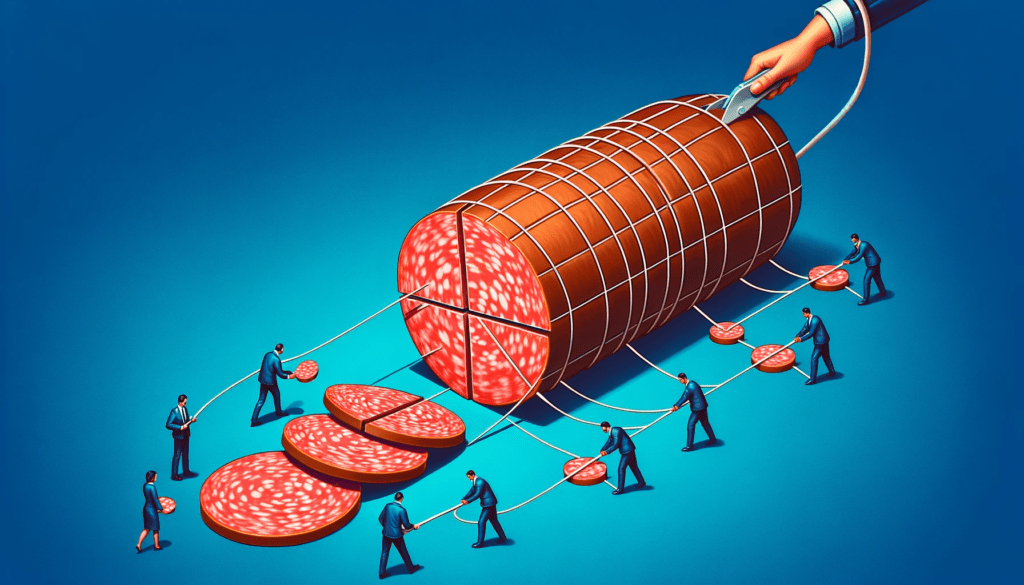
This image symbolizes the ‘Slice and Dice the Task’ concept, illustrating the approach of breaking down a big project into more achievable segments for easier handling and completion
Chapter 19 – Create Large Chunks of Time
Set aside large, uninterrupted time blocks for significant tasks. Plan these periods in advance and strictly adhering to them. By doing so, you can significantly enhance productivity and efficiency. This method is about focusing undivided attention on a task without distractions, leading to higher-quality work and faster completion.
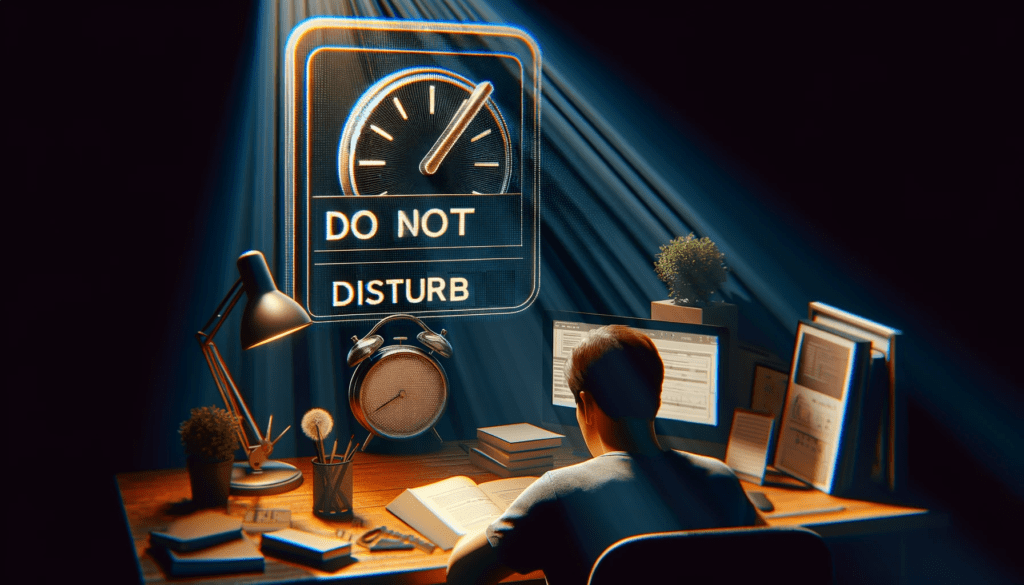
Chapter 20 – Develop A Sense of Urgency
Get yourself action orientated and develop a sense of urgency. By working continuously at a high level on high-value tasks, you can enter a state of “flow,” leading to increased efficiency and effectiveness.

The image illustrates the importance of time management and developing a sense of urgency, with the stopwatch or timer symbolizing the dedication to swift and effective action in task execution
Chapter 21 – Single Handle Every Task
Focus on one task at a time, seeing it through to completion without diversion. This approach significantly reduces the time needed to complete tasks and enhance overall productivity.
Applying these principles in daily life:
- Identify 1-3 “frog” tasks that are mission critical each day. Schedule these for when you have peak energy.
- Block off large chunks of time for focused work without distractions. Turn off notifications and avoid context switching.
- Apply the 80/20 rule to prioritize tasks with the biggest impact on key business goals. Delegate or outsource the rest.
- Break down larger goals into bite-sized daily goals so progress seems manageable.
Personally, I’ve found batching similar tasks and leveraging peak productivity hours to be very effective

Powerful Quotes from the book:
- “The key to success is to focus our conscious mind on things we desire, not things we fear.”
- “Your ability to choose between the important and the unimportant is the key determinant of your success in life and work.”
- “Discipline yourself to begin immediately and to persist until the task is complete before you go on to something else.”
- “One of the very worst uses of time is to do something very well that need not be done at all.”
- “The most valuable tasks you can do each day are often the hardest and most complex. But the payoff and rewards for completing these tasks efficiently can be tremendous.”
- “Never complain, never explain. Resist the temptation to defend yourself or make excuses.”
- “There is never enough time to do everything, but there is always enough time to do the most important thing.”
- “Goals are the fuel in the furnace of achievement.”

Final Thoughts: This book is a must-read for entrepreneurs, marketers, and anyone looking to improve their time management and productivity.
How will you eat your frog today? Share your thoughts or experiences with these strategies in the comments below.
Remember: Procrastination is the Entrepreneur’s Kryptonite
